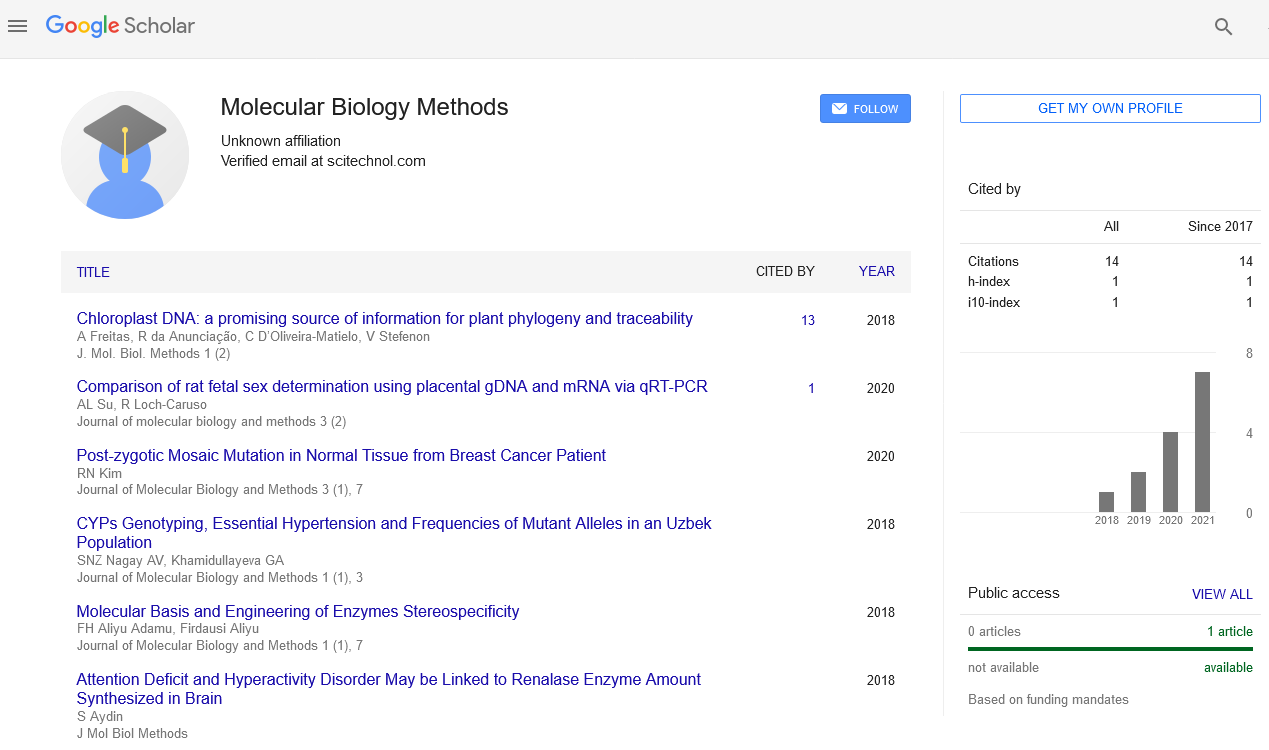Perspective, J Mol Biol Methods Vol: 4 Issue: 5
Tumor Immunology and Immunotherapy: Stem Cells in Benign Tumors
Karger Grunorg*
Department of Ophthalmology, College of Medicine, Seoul National University, Seoul, Korea
*Corresponding author: Karger Grunorg, Department of Ophthalmology, College of Medicine, Seoul National University, Seoul, Korea, E-mail: agkarger@hotmail.com
Received date: September 07, 2021; Accepted date: September 22, 2021; Published date: September 29, 2021
Keywords: Immunology
Introduction
As stem cells contribute to the development and homeostasis of normal adult tissues, malfunction of stem cells in self-renewal and differentiation has been associated with tumorigenesis. A growing number of evidences indicating that tumor initiating cells play a crucial role, not only in malignancies, but also in generation and development of benign tumors. Here we offer an overview of the identification and functional characterization of benign tumor initiating cells in several tissues and organs, which typically show capacities of uncontrolled self-renewal to fuel the tumor growth and abnormal differentiation to give rise to tumor heterogeneity. They may originate from alteration of normal stem cells, which confer the benign tumor initiating cells with different repertoire of “stemness”. The plastic functions of benign tumor initiating cells are determined by niche regulation mediated via several signaling and epigenetic cues. Therefore, targeting stem cell function represents an important strategy for understanding the biology and management of benign tumors. NRAGE, also known as Dlxin-1or MAGE-D1, is a member of type II Melanoma-Associated Antigen (MAGE) and plays an essential role in life activities, including differentiation, apoptosis, and cell cycle. Studies increasingly found that NRAGE is closely related to the tumor events, such as tumor occurrence, invasion, and metastasis. However, complex and contradictory functions of NRAGE in different circumstances are observed, suggesting that NRAGE is unique from other MAGE gene family members. This review summarizes recent findings concerning the structure and biological functions of NRAGE, which may provide a basis for a more comprehensive understanding of and further research on NRAGE. A germline insertion of a single nucleotide in the rat homologue of the human Birt-Hogg-Dubé (BHD) gene gives rise to dominantly inherited renal cell carcinoma (RCC) in the Nihon rat model. In this study, we established 7 lines (NR cell lines NR22, 24, 32, 45, 49, 54 and 64) from an RCC found in a Nihon rat. All cell lines consisted mainly of round or polygonal cells arranged in a cobblestone-like growth pattern. Cells of NR cell lines had abundant cytoplasm and tight junctions as well as microvilli on electron microscopy and were positive for cytokeratin on immunocytochemistry. Cell lines NR22, 24 and 32 showed rapid growth, whereas the growth of the remaining lines was very slow. While the modal chromosome number of lines NR24, 45 and 54 was 42, the remaining lines exhibited aberrant modal numbers ranging from 70 to 96. All NR cell lines formed tumors at subcutaneous inoculation sites in nude mice, and tumors from lines NR54 and 64 developed pulmonary metastases. All NR cell lines had a germline mutation in the rat Bhd gene in the gene analysis. NR cell lines would prove valuable experimental tools for studies on unique functions of the BHD gene and renal carcinogenesis. Retinoblastoma is the most common primary intraocular malignancy in children. With the progression of retinoblastoma, retinoblastoma cells lose their ability to differentiate. Regardless of many attempts to identify prognostic factors in retinoblastoma, further investigation for prognostic factors of retinoblastoma progression is still required because of the lack of sensitivity and specificity of these prognostic factors in predicting disease progression. We demonstrated that the differential expression of the neurotrophin receptors TrkA and TrkB is closely related to the differentiation of retinoblastoma cells. While retinoblastoma cells expressed TrkA as well as TrkB, their growth rates were not influenced by the addition of nerve growth factor to the culture medium. In experimental animal models of retinoblastoma, TrkA expression was primarily detected in more differentiated areas with high nm23 immunoreactivity whereas TrkB expression was apparent in more proliferative areas with high Ki67 immunoreactivity. With retinoicacid-induced differentiation of retinoblastoma cells, TrkA expression significantly increased whereas TrkB significantly decreased. The differential expression of TrkA and TrkB with differentiation of retinoblastoma cells was mediated by extracellular-signal-regulated kinase 1/2 activation, which was confirmed by immunocytochemistry of TrkA. Therefore, our results suggest that the differential expression of TrkA and TrkB could be valuable as a therapeutic target, for instance using specific inhibitors. As an important way to inactivate tumor suppressor genes (TSGs) during cancer development, promoter hypermethylation can be used to define novel TSGs and identify biomarkers for cancer diagnosis. SLC19A3 (solute carrier family 19, member 3) was found to be such a biomarker. SLC19A3 expression was downregulated in gastric cancer cell lines (71%, 5/7) and restored after pharmacological demethylation. Notably, hypermethylation of SLC19A3 promoter was detected in gastric cancer cell lines (57%, 4/7), primary gastric carcinoma tissues (51%, 52/101) and precancerous lesion (intestinal metaplasia) tissues (32%, 8/25). Exogenous SLC19A3 expression caused growth inhibition of gastric cancer cells. In summary, SLC19A3 was epigenetically downregulated in gastric cancer. Methylation of SLC19A3 promoter could be a novel biomarker for early gastric cancer development.
 Spanish
Spanish  Chinese
Chinese  Russian
Russian  German
German  French
French  Japanese
Japanese  Portuguese
Portuguese  Hindi
Hindi 